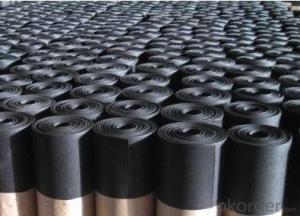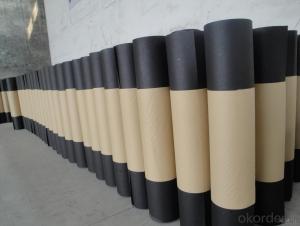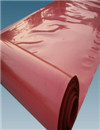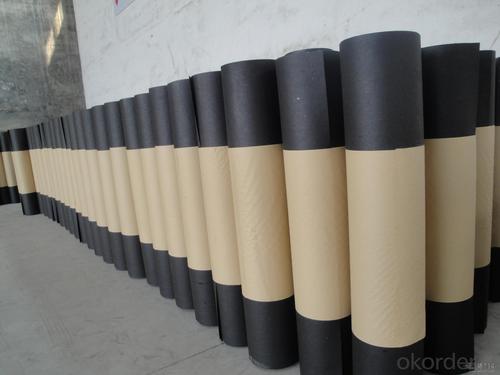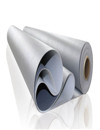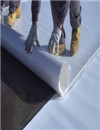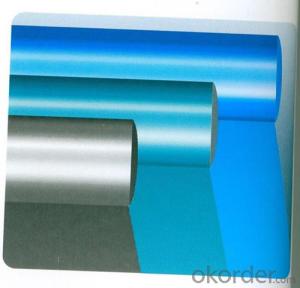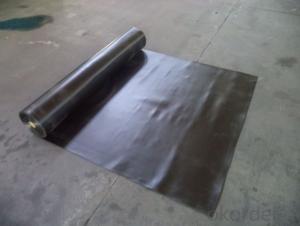EPDM Rubber Sheet for Waterproofing with 1.5mm Thickness
- Loading Port:
- Qingdao
- Payment Terms:
- TT OR LC
- Min Order Qty:
- 20000 m²
- Supply Capability:
- 600000 m²/month
OKorder Service Pledge
OKorder Financial Service
You Might Also Like
Specifications of EPDM Rubber Sheet with 1.5mm Thickness:
CE certification,in accordance with EN 13501-5:2005
homogenous epdm membrane.
ASTM standard D-7465,D-4637,
ISO9001 ISO14001
1.5mm epdm rubber roofing
EPDM waterproof membrane is of high elasticity among high polymer waterproof materials and becomes a world-popular waterproofing material. EPDM waterproof membrane is made from ternary ethylene-propylene rubber, which is designed for waterproofing of exposed and non-exposed applications. EPDM waterproof membrane production adopts the world-advanced equipment of cold feeding extrusion and continuous vulcanization technology.
Features of EPDM Rubber Sheet with 1.5mm Thickness:
Excellent weatherability, durability and size stability.
Good adaptability to high and low temperature, UV resistant and anti-corrosion.
High tensile strength and good elongation, accommodating substrate movement.
Easy installation, environment friendly.
Good rooting penetration resistance.
Service life up to 50 years.
Applications of EPDM Rubber Sheet with 1.5mm Thickness:
Subways, tunnels, roofs, basement.
Industrial and civil building waterproofing, like water reservior, bridge, dam, etc.
Geosynthetic liner for swimming pool, channels, irrigation system
Especially suitable for projects with high requirements in durability, anti-corrosion and deformation.
Technical Data of EPDM Rubber Sheet with 1.5mm Thickness:
Tensile Strength N/CM | Normal temperature: 60 ; 60°C: 30 |
Breaking Elongation % | Normal temperature: 400 ; -20°C: 10 |
Tear Resistance N | 20 |
Impermeability, 30 min no leakage | 0.3Mpa |
Low Temperature Bending °C | -20 |
Heating Shrinking mm | Extension: 2 Shrink: 4 |
Heat Resistance (80°C×168h) | Tensile Strength % : 80 ; Keeping rate of adhesive breaking:70 |
Alkali resistance (10% ca (oh)2 solution,normal temperature ×168h)) | Tensile Strength % : 80 ; Keeping rate of adhesive breaking:80 |
Synthetic aging | Tensile Strength % : 80 ; Keeping rate of adhesive breaking:80 |
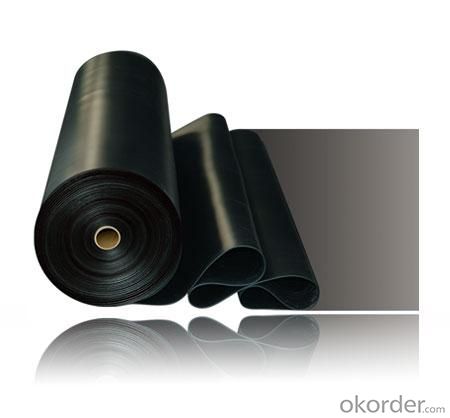
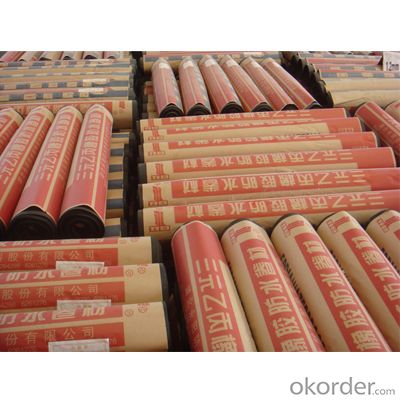
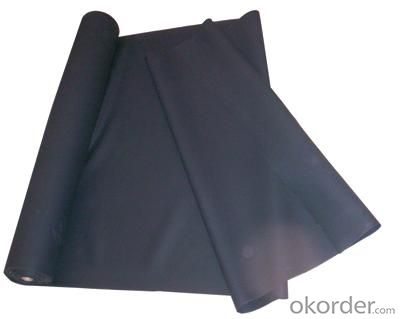
- Q: Can a waterproofing membrane be removed or replaced if necessary?
- If necessary, one can remove or replace a waterproofing membrane. Over time, these membranes may deteriorate or sustain damage, resulting in leaks or moisture seepage. In such instances, it becomes necessary to remove the current membrane and install a new one to ensure effective waterproofing. This removal and replacement process entails meticulously peeling away the old membrane, cleansing the surface, and applying a fresh membrane system. Consulting a skilled waterproofing contractor is crucial as they can evaluate the condition of the existing membrane and offer suitable guidance for its removal and replacement.
- Q: Can a waterproofing membrane be used for walkways or pedestrian bridges?
- Yes, a waterproofing membrane can be used for walkways or pedestrian bridges. Waterproofing membranes are designed to protect surfaces from water infiltration and can be applied to various structures, including walkways and pedestrian bridges, to prevent water damage and ensure their longevity.
- Q: Can a waterproofing membrane be used in conjunction with landscaping or hardscaping projects?
- Yes, a waterproofing membrane can be used in conjunction with landscaping or hardscaping projects. It can provide an additional layer of protection and help prevent water damage to structures or areas where landscaping or hardscaping is being done.
- Q: Can a waterproofing membrane be used on roofs with flat surfaces?
- Roofs with flat surfaces can indeed benefit from the application of a waterproofing membrane. In fact, it is quite common to use these membranes on flat roofs to safeguard against water infiltration. The primary function of these membranes is to establish a barrier that obstructs water from seeping into the roof structure and causing harm. Typically, they are constructed using materials like modified bitumen, EPDM, or PVC, which exhibit great resistance to both water and UV rays. To install the membrane, it can be done by torch-application, adhesive adherence, or mechanical fastening. To ensure optimal effectiveness and longevity of the waterproofing membrane on a flat roof, it is crucial to guarantee proper installation and regular maintenance.
- Q: Can a waterproofing membrane be used for underground bunkers?
- Underground bunkers can utilize waterproofing membranes to great effect. Designed to establish a formidable defense against moisture, these membranes effectively thwart water infiltration into structures. This renders them an optimal solution for underground bunkers, which are susceptible to water encroachment due to their subterranean nature. By affixing a waterproofing membrane to the walls and floor of the bunker, it becomes possible to avert water seepage and maintain a dry interior. This is of paramount importance for safeguarding any stored items or occupants within the bunker. Moreover, waterproofing membranes offer additional advantages, such as insulation and protection against radon gas. It is crucial to select a membrane explicitly crafted for underground applications and capable of withstanding the unique conditions and pressures associated with subterranean environments.
- Q: Are there any specific tools or equipment required for installing a waterproofing membrane?
- Yes, there are specific tools and equipment required for installing a waterproofing membrane. Some of the essential tools and equipment include: 1. Protective gear: This includes gloves, goggles, and a face mask to protect yourself from any harmful chemicals or fumes. 2. Cleaning equipment: Before installing the membrane, the surface needs to be clean and free from any dust, debris, or loose particles. Therefore, you may need a broom, vacuum cleaner, or pressure washer to clean the area properly. 3. Waterproofing membrane: The specific type of membrane will depend on the project requirements, but it is essential to have the appropriate membrane material and enough coverage to ensure a proper seal. 4. Primer: In some cases, a primer may be needed to enhance adhesion between the surface and the membrane. The primer type will depend on the surface material and the membrane being used. 5. Application tools: These tools are used to apply the membrane onto the surface. Common tools include brushes, rollers, or sprayers. The choice will depend on the type of membrane and the size of the project. 6. Seam tape: If the waterproofing membrane requires seams, a seam tape will be needed to ensure a watertight seal at the joints. The tape should be compatible with the membrane material. 7. Adhesive or adhesive tape: Some waterproofing membranes require an adhesive to bond them to the surface. Alternatively, adhesive tape can be used for self-adhesive membranes. 8. Cutting tools: Depending on the shape and size of the area to be waterproofed, you may need cutting tools such as utility knives or scissors to trim the membrane to the desired size and shape. 9. Caulking gun: A caulking gun is necessary for applying sealant or caulk to fill any gaps or cracks in the surface before installing the membrane. 10. Drying equipment: After the membrane is installed, it may require a certain amount of time to dry or cure. Fans or dehumidifiers may be needed to accelerate the drying process, depending on the specific membrane and environmental conditions. It is important to consult the manufacturer's guidelines or seek professional advice to ensure you have all the necessary tools and equipment for a successful installation of the waterproofing membrane.
- Q: Can a waterproofing membrane be used for tunnels and underground structures?
- Yes, a waterproofing membrane can be used for tunnels and underground structures. Waterproofing membranes are commonly used in construction to provide a barrier against water infiltration and protect structures from potential damage caused by water. In the case of tunnels and underground structures, where there is a higher risk of water ingress due to the surrounding soil and groundwater, waterproofing membranes are essential to ensure the integrity and longevity of the infrastructure. Waterproofing membranes for tunnels and underground structures are specifically designed to withstand the unique challenges posed by these environments. They are typically made of durable and flexible materials such as bitumen, PVC, or EPDM, which can effectively resist water pressure and provide long-lasting protection. Additionally, these membranes are often reinforced with various layers or fabrics to enhance their strength and resistance to puncture or tear. The application of waterproofing membranes in tunnels and underground structures involves a meticulous process. The surfaces that need to be waterproofed, such as the walls and floors, are thoroughly cleaned and prepared to ensure proper adhesion of the membrane. The membrane is then applied in multiple layers, ensuring complete coverage and a seamless seal. Special attention is given to critical areas such as joints, corners, and penetrations to prevent any potential weak points. By using a waterproofing membrane, tunnels and underground structures can be effectively protected from water intrusion, groundwater pressure, and potential damage caused by moisture. This helps to maintain the structural integrity of the infrastructure, prevent water-related problems such as leaks, corrosion, or deterioration, and ensure the safety and functionality of the tunnel or underground facility.
- Q: Can a waterproofing membrane be used for a podium deck coating?
- A podium deck coating can indeed utilize a waterproofing membrane. The purpose of a waterproofing membrane is to establish a barrier between the structure and the external surroundings, thereby warding off water infiltration and safeguarding the underlying surface. Podium decks, commonly present in commercial buildings or outdoor areas, are prone to water harm as a result of exposure to weather conditions. By applying a waterproofing membrane to the podium deck, water penetration can be effectively averted, guaranteeing long-term protection against issues related to moisture, such as leaks, mold, and deterioration. Furthermore, certain waterproofing membranes can provide added advantages, including UV resistance, crack bridging capabilities, and aesthetic enhancements. Nevertheless, it is crucial to take into account factors such as the specific requirements of the podium deck, the type of membrane employed, and the expertise of the applicator to ensure proper installation and compatibility with the deck substrate.
- Q: Can a waterproofing membrane be used for loading docks or ramps?
- Certainly! A waterproofing membrane proves useful for loading docks and ramps. Its purpose lies in safeguarding surfaces against water damage by forming a barrier that halts the intrusion of water. As loading docks and ramps remain exposed to diverse weather conditions, they often fall victim to water seepage, leading to gradual harm. By applying a waterproofing membrane to these areas, one can avert water infiltration, thus shielding the structure and extending its lifespan. Furthermore, this membrane offers supplementary advantages like enhanced slip resistance, defense against chemical spills, and decreased maintenance expenses.
- Q: What is called a waterproof roll dry shop, wet shop
- Dry shop, wet shop is said self-adhesive coil. Dry shop is in the formation of the grass on the first layer of primary treatment agent, and then paving self-adhesive coil method is the easiest and fastest way.
Send your message to us
EPDM Rubber Sheet for Waterproofing with 1.5mm Thickness
- Loading Port:
- Qingdao
- Payment Terms:
- TT OR LC
- Min Order Qty:
- 20000 m²
- Supply Capability:
- 600000 m²/month
OKorder Service Pledge
OKorder Financial Service
Similar products
Hot products
Hot Searches
Related keywords
